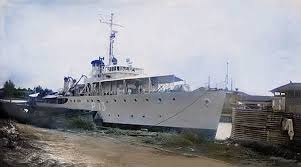During the desperate early months of the Pacific War, Allied cooperation in Southeast Asia was marked by confusion, mismatched priorities, and poor coordination. Dutch naval forces, particularly the Royal Netherlands Navy (RNN) submarine fleet based in the Netherlands East Indies (NEI), played a critical role in resisting the Japanese advance. Yet, as both Major Rene van den Berg and historian Jack Ford document, Dutch tactics—especially their innovative use of submarine “hunting groups”—were initially ignored by British and American commanders. Only after serious losses did Allied forces begin to adopt the very strategy the Dutch had proposed from the outset.
Dutch submarine doctrine: a layered defence system
The Dutch developed a distinctive naval doctrine well before the war, suited to the geography of the NEI. According to van den Berg’s Unchained Interests, the RNN trained its submarines to operate in coordinated hunting groups, supported by long-range reconnaissance from the Dutch Naval Air Service (MLD). These layered operations were designed to detect, track, and ambush Japanese convoys en route to the NEI.
Jack Ford, in Allies in a Bind, adds critical detail: Dutch submarines had practised these tactics for years and had proven their effectiveness in exercises. When war broke out, this strategy was ready to deploy—but was effectively dismantled by Allied command decisions. Under the American-led ABDA (American-British-Dutch-Australian) command, RNN submarines were ordered to patrol individually, in line with US and British doctrine, which did not favour coordinated “wolf pack” tactics.
British mismanagement in Malaya and Singapore
This misalignment had serious consequences. Ford explains that Dutch submarine losses during the Malaya and Singapore campaigns were high—not because of faulty Dutch tactics, but because British commanders failed to coordinate air cover or recognise the operational advantages of Dutch hunting methods. The submarines were tasked to patrol unfamiliar waters, sometimes without accurate charts, and were often left without reconnaissance support. The result was not only the loss of several experienced Dutch crews, but also the breakdown of an integrated defence strategy that could have delayed or disrupted Japanese landings.
Van den Berg’s analysis confirms this, noting that “the Dutch lost the advantage of their forces’ tactical training” due to Allied neglect. The submarine fleet, deprived of its aerial “eyes,” was left blind.
Belated imitation—and lessons for Australia
Ironically, both sources note that by mid-1942, Allied naval forces began to adopt Dutch-inspired hunting tactics. The US Navy would go on to develop its own version of the “wolf pack” concept in the Pacific, with notable success. However, the early refusal to trust or integrate Dutch methods had already cost the Allies valuable time and resources.
For Australia, the lesson was particularly sharp. As a key base for Allied logistics and air support in the region—especially through Darwin—Australia was directly affected by the failure of early coordination. Australian destroyers, like HMAS Stuart and HMAS Vampire, were engaged in desperate convoy escorts, yet lacked strategic visibility into Dutch planning. Worse, the early loss of the submarine screening in areas like the Makassar Strait and the South China Sea opened pathways for Japanese advances toward Timor and northern Australia.
Australian naval leaders, while initially more aligned with British doctrine, gradually began to appreciate the effectiveness of Dutch submarine warfare. Cooperation between the Royal Australian Navy and the RNN improved as the war progressed, especially in shared use of Australian ports for submarine maintenance and crew rest.
Conclusion
The tragedy of missed opportunity in the early Pacific War is well illustrated in the sidelining of Dutch submarine tactics. As Jack Ford shows in Allies in a Bind, and van den Berg confirms in Unchained Interests, the Dutch brought to the table a tested, coherent naval doctrine—only to see it ignored, undermined, and eventually copied after heavy losses. For Australia, this episode is a reminder of the costs of poor coalition integration and the value of listening to smaller allies, especially those with deep regional experience.
References:
Van den Berg, R.W.A. (2021). Unchained Interests: American-British-Dutch-Australian Command 1942. Netherlands Staff College Monograph.
Ford, J. (2001). Allies in a Bind: Australia and the Netherlands East Indies in the Second World War. CQU Press.


